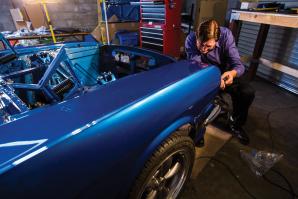When Sacramento-based Aerojet decided to convert part of a superfund site into a solar field, it sought bids from companies across the country. The project, after all, would be big — 35 acres ultimately generating six megawatts of power, making it one of the largest industrial solar projects in the country.
Among the bidders, one company stood out in particular: Roseville-based Solar Power Inc.
“They were a solid business, and the fact that they were local weighed into our consideration,” says Michael Girard, manager of sustainability for Aerojet, which finished the project in 2010 through a partnership with SPI and the Sacramento Municipal Utility District.
That type of reasoning is music to the ears of those leading the Capital Region’s burgeoning clean-tech sector. The Sacramento metro area has more than 37,000 clean jobs, according to the 2011 “Sizing the Clean Economy” report from The Brookings Institution, which defines clean jobs as those involved in producing a range of clean products, from goods such as wind turbines to services such as mass transit. Each of those jobs creates nearly $5,000 in exports.
That’s big business, but where are those exports headed? Some
companies like SPI have established themselves as national
players, so many goods will not stay local.
Still, some industry insiders see missed connections between
local buyers and providers of clean-tech goods and services.
Stronger ties would do more than help individual businesses and
the industry as a whole; they would help the entire region
prosper, says Gary Simon, chairman of CleanStart, an initiative
of the Sacramento Area Regional Technology Alliance (SARTA) that
focuses on development of the region’s clean-technology
ventures.
“The spillover effect of buying from a local supplier is three times what it would be from buying outside the area. Money spent locally is re-spent locally to a much higher degree.”
Gary Simon, chairman, CleanStart
There are two main benefits to fostering stronger provider/consumer links, Simon says. “First, the spillover effect of buying from a local supplier is three times what it would be from buying outside the area. Money spent locally is re-spent locally to a much higher degree,” he says. “Second, it helps the industry become self-sustaining simply by having a greater volume of activity locally. Once an industry hits that tipping point, it grows really fast.”
There’s no magic bullet for getting there, no one thing that will create an instant interconnected web of local buyers and providers. Most efforts at bridging the disconnect are focused on the ongoing education and support of clean-tech companies and creating an overall sense of community among the industry, including major corporations involved in sustainability practices.
SARTA, for example, holds seminars throughout the year with topics such as ‘selling to large enterprises’ aimed at clean-tech companies. The group’s annual Clean Tech Showcase this year also features a panel of companies that buy such goods and services.
The idea, says SARTA CEO Meg Arnold, is not to create special criteria for local clean-tech businesses looking to sell to major players. It’s about making sure these companies — which by nature are entrepreneurial and nimble — understand the opportunities out there as well as the frameworks larger companies often have in place.
“Some of the companies doing major work in sustainability are the larger corporate players with multiple locations and vendor policies in place,” Arnold says. “Our challenge is making sure that we are providing ways for our local clean-tech companies to knowledgeably sell into these larger entities, but not setting up expectations that just because a company has a local office that (the local clean-tech company) is going to circumvent these vendor policies.”
Grant Grable, vice president and value stream leader of Sacramento-based Sunoptics, understands that but says he also sees value in cultivating relationships with local employees of major players. Those people can become what Grable terms “white knights” — people with influence on the inside (or even third-party consultants) who can deliver a clean-tech company’s message as their own.
Grable knows what he’s talking about.
Sunoptics, which manufactures high-performance prismatic skylights with lighting controls, has successfully sold to a whole list of household names — Wal-Mart, Best Buy and Home Depot, among others. And although the company has been in business for more than three decades — a veritable veteran in the clean-tech industry — much of its growth has been fairly recent.
Having experienced 40 percent growth in each of the past three years, Sunoptics began actively putting into place principles Grable advises emerging clean-tech companies to follow, including focusing on assistance from third parties. That means everything from seeking outside verification of claims and financial models to leveraging success stories from past customers.
The bottom line, he says, is for companies to do their homework beforehand and anticipate — and overcome — potential skepticism, especially about new technologies.
“An engineer can have the greatest product, but if you haven’t put all your ducks in a row and don’t have all the people lined up, all the documentation, you’re just a salesperson,” Grable says.
The other angle of educating clean-tech companies is making them aware of existing opportunities. SMUD, for example, has an extensive Supplier Education and Economic Development (SEED) program that connects small-business customers to contracting opportunities with the utility. Though not targeted exclusively to clean-tech companies, the program has assisted the clean-tech sector in particular. That’s because SMUD has consistently purchased clean-technology goods and services for decades, thus helping foster a local market, says Elisabeth Brinton, SMUD’s chief business and public affairs officer.
Once a business is added to the SEED list of suppliers, it is notified any time a procurement opportunity arises in its category. Certain smaller procurements are first offered only to SEED companies, and some larger contracts offer incentives for using SEED companies. The utility routinely holds workshops about SEED.
“It’s not just how we contract with companies but also how we recruit them and grow them and support our overall economy,” Brinton said. “We want to make sure everything within our service territory is as healthy and as robust as possible.”
Girard takes a broad view as well. For the clean-tech market to grow, education needs to happen not just for clean-tech companies, but also for other types of business in the region. He sees his role not only as sustainability promoter within Aerojet, but also as a “preacher” to other businesses. His pitch is simple: Even nongreen businesses can have a positive impact on the environment by considering sustainability projects. And if they pursue them, he says, there is a clean-tech industry right here.
Using local companies can expand a project’s impact well beyond the environmental aspect, something Michael Anderson, vice president of corporate communications for SPI, noticed while visiting the Aerojet project during installation.
“One of the things that struck me when I walked out there was the lack of the SPI logo,” Anderson says. “I’m the brand evangelist, so I noticed that. But then I looked around again and saw that all the trucks had different logos and that every single one of them had a 916 area code on them. There were a lot of people being put to work because of Aerojet, SPI and SMUD.”
That, industry supporters point out, is the true power of forging connections between local providers and local buyers.
Recommended For You

Classics Gone Green
A new take on an old favorite
Gary Morton has a dream and a car. If his dream comes true, like those of Henry Ford and Karl Benz before him, Morton will turn his prototype into a car company.
But Morton is not looking to build a big assembly plant or an extensive dealer network. His production will be limited to just one model that will offer baby boomers the nostalgia of the muscle cars they drove in their youth alongside their modern commitment to a pollution-free environment.

It’s Impolite to Squat
EV owners find it increasingly difficult to plug in
Long before it was widely accepted, Sacramento attorney Mike Polis bought his first electric vehicle. He got started with a Toyota Prius, later upgraded to a Nissan Leaf and now drives a white Chevy Volt. On average, he saves more than $3,500 a year over his gas-powered counterparts, he can use the HOV lane as a single occupant and he charges his car for free at work.


